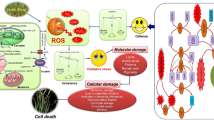Abstract
Mechanisms of avoidance and protection against light damage were studied in the resurrection plants Craterostigma wilmsii and Xerophyta viscosa.
In C. wilmsii, a combination of both physical and chemical changes appeared to afford protection against free radical damage. During dehydration leaves curled inwards, and the abaxial surface became exposed to light. The tissue became purple/brown in colour, this coinciding with a three-fold increase in anthocyanin content and a 30% decline in chlorophyll content. Thus light-chlorophyll interactions are progressively reduced as chlorophyll became masked by anthocyanins in abaxial layers and shaded in the adaxial layers. Ascorbate peroxidase (AP) activity increased during this process but declined when the leaf was desiccated (5% RWC). During rehydration leaves uncurled and the potential for normal light-chlorophyll interaction was possible before full hydration had occurred. Superoxide dismutase (SOD) and glutathione reductase (GR) activities increased markedly during this stage, possibly affording free radical protection until full hydration and metabolic recovery had occurred.
In contrast, the leaves of X. viscosa did not curl, but light-chlorophyll interactions were minimised by the loss of chlorophyll and dismantling of thylakoid membranes. During dehydration, free radical protection was afforded by a four-fold increase in anthocyanin content and increased activities of AP, GR and SOD. These declined during rehydration. It is suggested that potential free radical damage may be avoided by the persistence of anthocyanins during the period of thylakoid membrane re-assembly and full chlorophyll restitution which only occurred once the leaves were fully rehydrated.
Similar content being viewed by others
References
Bewley JD and Oliver MJ (1992) Desiccation tolerance in vegetative plant tissues and seeds: Protein synthesis in relation to desiccation and a potential role for protection and repair mechanisms. In: GN Somero, CB Osmond and CL Bolis (eds) Water and Life: Comparative analysis of water relationships at the organismic cellular and molecular levels, pp 141-160. Heidelberg: Springer-Verlag
Elstner EF and Heupel A (1976) Inhibition of nitrite formation from hydroxyl ammonium chloride: a simple assay for superoxide dismutase. Anal Biochem 70: 616-620
Hallam ND and Luff SE (1980) Fine structural changes in the mesophyll tissue of the leaves of Xerophyta villosa during desiccation. Bot Gaz 141(2): 173-179
Hopkins WG (1992) Introduction to plant physiology, pp 125- 140. New York, John Wiley &; Sons Inc.
Ingram J and Bartels D (1996) The molecular basis of dehydration tolerance in plants. Ann Rev Plant Physiol Plant Mol Biol 47: 377-403
Larson A (1988) The antioxidants of higher plants. Phytochem 27(4): 969-978
Lichtenthaler HK (1987) Chlorophylls and carotenoids: pigments of photosynthetic biomembranes. Methods in Enzymology 148: 350-383
Malan C, Greyling MM and Gressel J (1990) Correlation between CuZn superoxide dismutase and glutathione reductase, and environmental and xenobiotic stress tolerance in maize inbreds. Plant Science 69: 157-166
Mancinelli AL, Yang C-PH, Lindquist P, Anderson OR and Rabino I (1975) Photocontrol of anthocyanin synthesis. III The action of streptomycin on the synthesis of chlorophyll and anthocyanin. Plant Physiol 55: 251-257
McCord JM and Fridovich I (1969) Superoxide dismutase, and enzymatic function for erythrocuprein (hemocuprein) J Biol Chem 244: 6049-6055
Muslin EH and Homann PH (1992) Light as a hazard for the desiccation-resistant “resurrection” fern Polypodium polypoides L. Plant Cell &; Environ 15: 81-89
Seel WE, Hendry GA and Lee JA (1992) Effects of desiccation on some activated oxygen processing enzymes and antioxidants in mosses. J Exp Bot 43(253): 1031-1037
Sgherri CLM, Loggini B, Puliga S and Navari-Izzo F (1994) Antioxidant system in Sporobolus stapfianus: changes in response to desiccation and rehydration. Phytochem 35(3): 561-565
Sgherri CLM, Loggini B, Bochicchio A and Navari-Izzo F (1994) Antioxidant system in Boea hygroscopica: changes in response to desiccation and rehydration. Phytochem 35(3): 377-381
Sherwin HW and Farrant JM (1996) Differences in rehydration of three desiccation-tolerant angiosperm species. Ann Bot 78: 703-710
Smirnoff N (1993) The role of active oxygen in the response of plants to water deficit and desiccation. New Phytol 125: 27-58
Swain T (1965) Nature and properties of flavonoids. In: T.W. Goodwin (ed) Chemistry and Biochemistry of Plant Pigments. London and New York: Academic Press
Tuba Z, Lichtenthaler HK, Csintalan Z, Nagy Z and Szente K (1994) Reconstitution of chlorophylls and photosynthetic CO2 assimilation upon rehydration of the desiccated poikilochlorophyllous plant Xerophyta scabrida (Pax) Th. Dur. et Schinz. Planta 192: 414-420
Vertucci CW and Farrant JM (1995) Acquisition and loss of desiccation tolerance. In: J Kigel and G Galili (eds) Seed development and germination, pp 237-271. New York: Marcel Dekker Inc.
Wang SY, Jiao HJ and Faust M (1991) Changes in ascorbate, glutathione, and related enzyme activities during thidiazuroninduced bud break of apple. Physiol Plant 82: 231-236
Author information
Authors and Affiliations
Rights and permissions
About this article
Cite this article
Sherwin, H.W., Farrant, J.M. Protection mechanisms against excess light in the resurrection plants Craterostigma wilmsii and Xerophyta viscosa. Plant Growth Regulation 24, 203–210 (1998). https://doi.org/10.1023/A:1005801610891
Issue Date:
DOI: https://doi.org/10.1023/A:1005801610891




